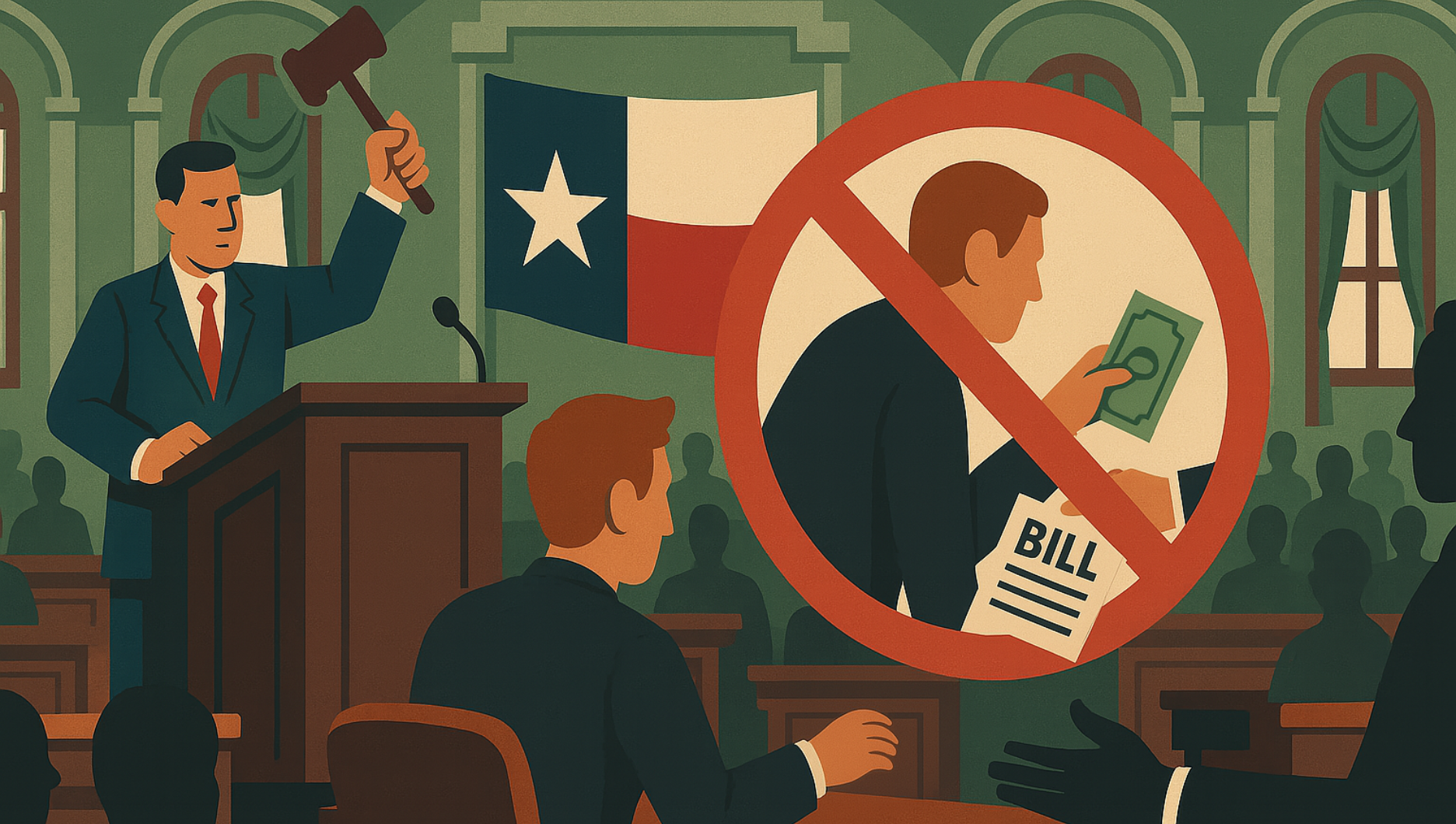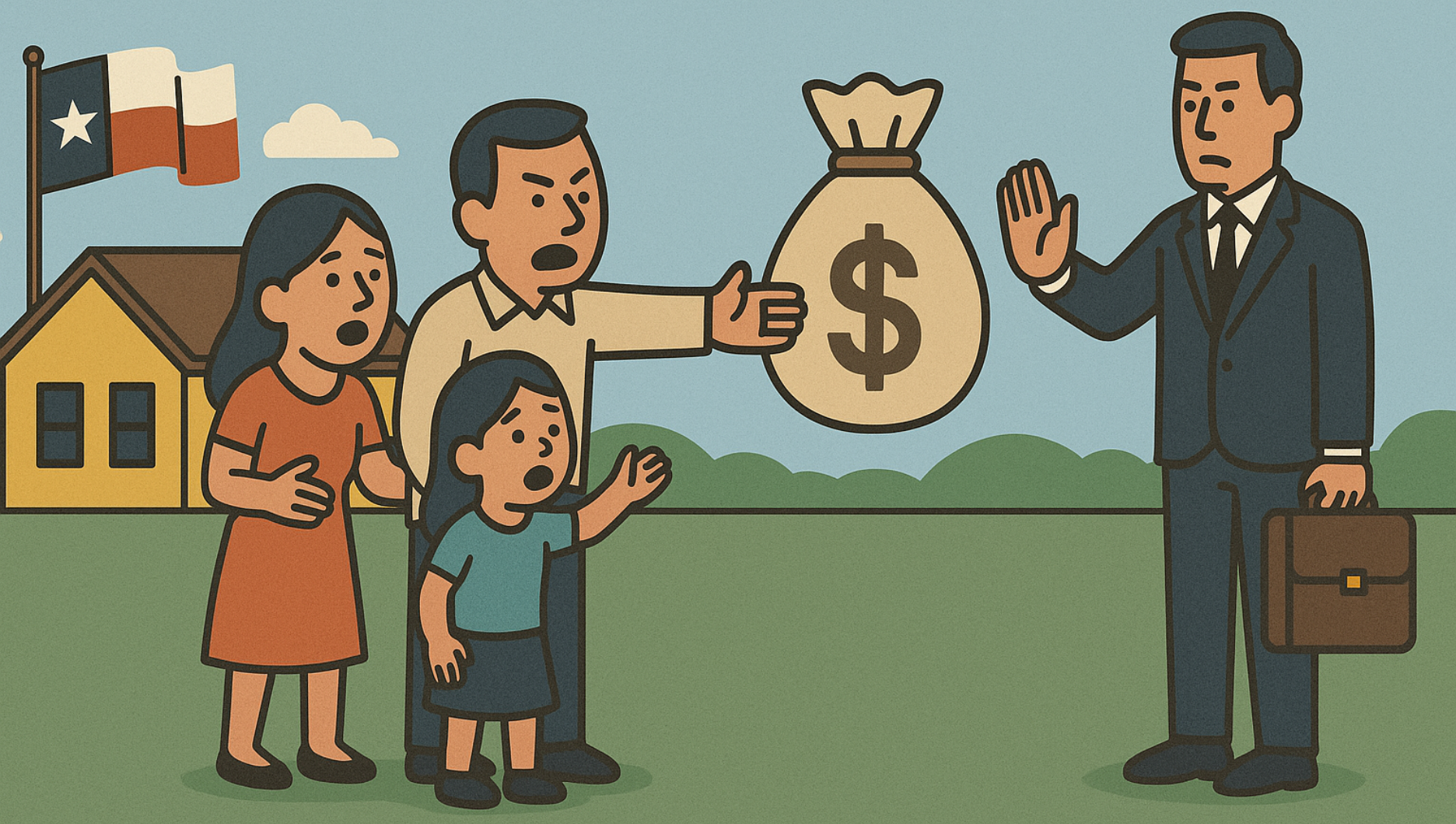Texans Will Get Less Than $4 Billion Out of the $24 Billion Budget Surplus
Executive Summary
Though it is difficult to discern from recent statements made by Texas’ legislative leaders, the Texas Senate has budgeted only $3 billion for new property tax relief this session and the Texas House has proposed $3.5 billion (Figure 1). This is the case even though Texas has a current budget surplus of $24 billion and will have many more billions in new revenue coming online during the upcoming 2026-27 fiscal biennium.
| Figure 1: Breakdown of Property Tax Costs in Proposed Senate and House Budgets | |
| Provision | Cost |
| Maintaining Property Tax Relief from 2019, 2021, & 2023 | $44.5 Billion |
| Additional Tax Compression in Current Law (adopted in 2019) | $3 Billion |
| New Relief Proposed in the 2026-27 Budget | $3 Billion (Senate) $3.5 Billion (House) |
Why is this happening? The bottom line is a string of poor decisions by the Texas Legislature that allow local governments and school districts to greatly increase spending and property taxes (Figure 2) every year. These decisions greatly increase the costs of maintaining previous, largely ineffective, legislative efforts to provide property tax relief.
| Figure 2. Texas Property Tax Growth 2018-2024 | ||||||
| Year | Special Districts | Counties | Cities | School Districts | Total Levy | % |
| 2018 | $8,485,263,910 | $9,602,798,872 | $10,387,752,412 | $34,723,549,607 | $63,199,364,801 | 5.08% |
| 2019 | $8,909,719,354 | $10,423,290,377 | $11,146,148,401 | $36,065,930,857 | $66,545,088,989 | 5.29% |
| 2020 | $9,486,152,671 | $11,290,528,493 | $11,963,476,245 | $37,759,657,465 | $70,499,814,874 | 5.94% |
| 2021 | $10,400,963,921 | $11,694,130,764 | $12,495,940,682 | $38,946,142,782 | $73,537,178,149 | 4.31% |
| 2022 | $10,409,180,231 | $12,797,292,169 | $13,634,471,866 | $43,949,038,027 | $80,789,982,293 | 9.86% |
| 2023 | $12,723,403,616 | $14,174,524,582 | $15,049,228,873 | $39,496,580,852 | $81,443,737,923 | 0.81% |
| 2024 | $13,497,615,446 | $15,649,705,718 | $15,630,827,678 | $42,039,642,543 | $86,817,791,385 | 6.60% |
| Change | $5,012,351,536 | $6,046,906,846 | $5,243,075,266 | $7,316,092,936 | $23,618,426,584 | 37.37% |
Figure 3 highlights one of the many poor decisions that the Texas Legislature keeps making. The Legislature has, in recent years, dedicated much more of its budget surpluses to new spending than it has to property tax relief. Figure 3 contains only a partial list of new spending in the 2026-27 Texas budget based on a statement by Texas Lt. Gov. Dan Patrick. Many billions more will be spent by the Texas Legislature instead of being returned to Texas taxpayers.
| Figure 3: Property Tax Relief vs New Spending in the Proposed 2026-27 Texas Budget | |
| Budget Surplus | $23,760,000,000 |
| Property Tax Relief | $3,000,000,000 |
| New Spending | $17,656,000,000 |
What Does “New” Mean?
Recent statements by Texas’ legislative leaders can be confusing for Texans attempting to discern how much property tax relief may actually result from this session. For instance,
“Provides $26.3 billion for the ongoing cost of the $100,000 homestead exemption and 10.6 cents of rate compression adopted by the 88th Legislature; Provides $3 billion for 6.8 cents of additional rate compression through existing mechanisms by FY27; Provides $3.5 billion for new property tax relief, contingent on legislation, for a total of $6.5 billion in new relief.” – House Speaker Dustin Burrows
“$32.2 billion to extend last biennium’s record-setting tax cuts, provide additional compression under HB 3 (86R, 2019), and increase the homestead exemption to $140,000 for regular homeowners and $150,000 for seniors. This brings the total state funds provided for property tax relief to $51 billion since the passage of HB 3 (86R).” – Lt. Gov. Dan Patrick
“Assumes $51 billion in property tax relief since 2019, including the following amounts appropriated to the Foundation School Program for the 2026-27 biennium: $3 billion to further compress school district M&O tax rates under HB 3 (86R) provisions, $3.5 billion to maintain relief provided by SB 2 (88-2), $3 billion to raise the homestead exemption by $40,000, and $500 million to provide tax relief to businesses.” – Sen. Joan Huffman
Much of the confusion is based on discussions from 2023 about the amount of new property tax relief the Texas Legislature was providing. Many policymakers claimed that Texans were getting “$18 billion in property tax cuts—the largest property tax cut in Texas history.” However, according to the Legislative Budget Board, the amount of new relief was only $12.7 billion:
A number of people (here, here, and here) pointed out the problem with the $18 billion claim. But the policymakers had to stick with the $18 billion to stay in line with Gov. Abbott’s promise of dedicating at least half of the $32 billion budget surplus in 2023 to property tax relief. Obviously a $12.7 billion property tax cut would not be enough to reach that goal (Sen. Paul Bettencourt used similar reasoning at the recent Senate Finance hearing to claim that the 2023 property tax cut has now become “a super record $22.7 billion” tax cut—see more below).
This session, the talk of new relief is still present but is mixed in with discussions of cumulative spending on tax relief since 2019. This is true even in the recently filed appropriations bills themselves, with new language added that confuses the issue: both the House and Senate bills have added nearly identical language citing the $51 billion figure that both Patrick and Huffman mentioned.
Comparing the bills this session with the appropriation bills from last session confirms that the new relief is only $3.5 billion in House Bill 1 and $3 billion in the Senate Bill. This is because new relief is contingent upon new legislation passing, and there is only one contingency rider in each appropriations bill that provides additional relief:
Speaker Burrows’ statement on the issue said there would be “a total of $6.5 billion in new relief” in the budget. But that statement is dependent on what “new” means when it comes to the effects on Texas property taxpayers. As Figure 1 shows, $3 billion of the $6.5 billion that Burrows refers to as new relief comes from additional tax compression required by a provision in current law adopted in 2019. If the Legislature did nothing with tax relief this session, we would still get this. It is automatically included in the budget and is part of the Comptroller’s budget certification calculations. It may be additional compression, but it was promised long ago; it is not “new” tax relief.
A Breakdown
Let’s look again at Figure 1, which breaks down the $51 billion of property tax costs contained in the proposed budgets from the House and Senate:
| Figure 1: Breakdown of Property Tax Costs in Proposed Senate and House Budgets | |
| Provision | Cost |
| Maintaining Property Tax Relief from 2019, 2021, & 2023 | $44.5 Billion |
| Additional Tax Compression in Current Law (adopted in 2019) | $3 Billion |
| New Relief Proposed in the 2026-27 Budget | $3 Billion (Senate) $3.5 Billion (House) |
According to testimony by the Legislative Budget Board during a recent hearing of the Texas Senate’s Committee on Finance (starting at -4:37:28), $44.5 billion of the $51 billion of costs is to maintain property tax relief adopted in 2019, 2021, and 2023.
But this raises a question.
The original biennial cost estimates of these property tax provisions were only $23.8 billion ($5.1 billion in 2019; $741 million in 2021, and $18 billion in 2023). Why do they now cost $44.5 billion? The answer is because of poor decisions made by the Texas Legislature and one poor decision made by the Texas Education Agency (TEA).
We’ll start with the TEA. In 2023, the Texas Legislature increased the homestead exemption on school property taxes from $40,000 to $100,000. However, when the TEA calculated the 2023 Tier 1 tax rate for school districts on which the entire system is based, they used the $40,000 exemption. This increased the cost to the state by about $2.35 billion, which is now included in the $44.5 billion maintenance cost. Unfortunately, this cost was a windfall for school districts; the increased cost was not passed along to homeowners as tax relief. This, plus another miscalculation of about $2.35 billion related to “hold harmless” provisions increased the costs of the property tax bill last session by $4.7 billion, which is how Sen. Bettencourt arrived at his “a super record $22.7 billion” tax cut.
The list of poor decisions by the Texas Legislature is extensive, but they all fall into one general category: a refusal to control state and local spending.
For instance, about $3 billion of the costs for this biennium come from hold harmless provisions in the tax law that limit the effects of the tax relief on specific school districts. Another $3 billion comes from a 2019 law that requires additional compression if property value growth exceeds 2.5%. The main cost driver, though, is the ability of school districts and local governments to increase property tax revenue at high rates—5.4% per year since 2018 in addition to tax relief, far exceeding alleged limits on increases. This is happening because the Texas Legislature has not made a serious effort to restrict runaway spending and property tax increases by Texas school districts and local governments.
| Figure 4: Texas State Spending and Local Government Revenue Growth 1997-2024 | ||
| Entity | Taxes/Spending 1997 | Taxes/Spending 2023*/24 |
| State of Texas (spending) | $40,252,108,906 | $198,978,121,000* |
| School Districts | $10,394,500,372 | $42,039,642,543 |
| Cities | $2,847,081,480 | $15,630,827,678 |
| Counties | $2,658,308,076 | $15,649,705,718 |
| Special Purpose Districts | $1,759,622,591 | $13,497,615,446 |
The results of these poor decisions can be seen in Figure 4, which shows how much state spending and local property taxes have increased since 1997, the first year the Texas Legislature started acting on property tax relief. The consequences of these decisions are twofold. First, increased state spending means less ability of the state to reduce or eliminate property taxes. Second, increased local property taxes—driven by increased local spending—means that the property tax burden on taxpayers keeps increasing, as do the costs of paying for previous efforts of property tax relief. And there is no end to this in sight. For instance, a review of the recently announced spending and legislative priorities in the Texas Senate show that excessive state spending growth is likely to continue while there will probably be no effort to restrict the ability of local governments and schools to increase property taxes.
Conclusion
During the discussions on property taxes in a recent Senate Finance Committee hearing, several senators made comments about the burden of continuing to pay for previous property tax relief measures, as one noted that “politically, we don’t get any credit for it.”
The reason they do not get credit is because no matter how much of our money they give to local school districts in the name of providing property tax relief, property taxes keep increasing at a rapid pace.
The solution to this is simple. If Texas politicians want credit from taxpayers, they must actually and permanently reduce property owners’ tax bills by putting strict limits on state spending and local property tax growth and devoting at least 90% of state budget surpluses to eliminating school property taxes.
Texans for Fiscal Responsibility relies on the support of private donors across the Lone Star State in order to promote fiscal responsibility and pro-taxpayer government in Texas. Please consider supporting our efforts! Thank you!
Get The Fiscal Note, our free weekly roll-up on all the current events that could impact your wallet. Subscribe today!




